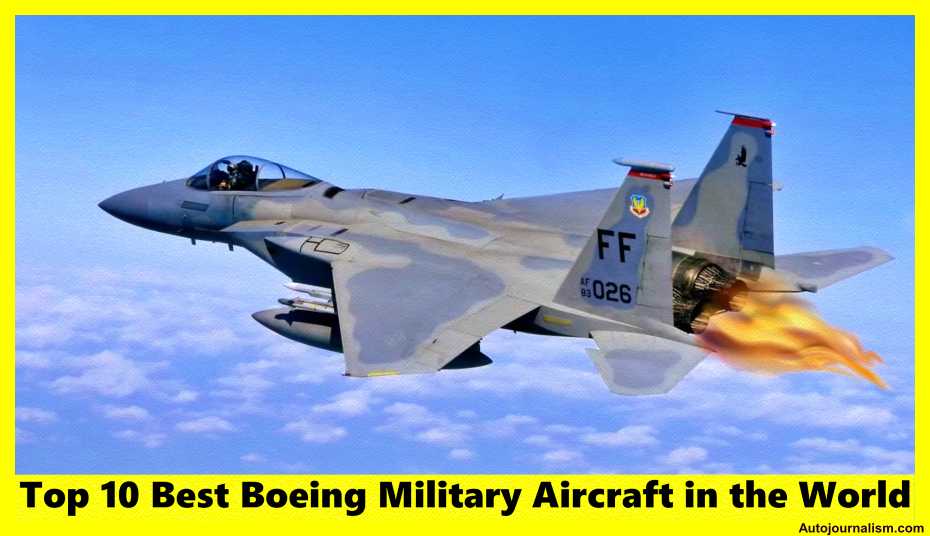Top 10 Best Boeing Military Aircraft in the World
Table of Contents
Today we have shared the list of the Top 10 Best Boeing Military Aircraft in the World, in 2024 with HD images and Tables, You can download this page as a PDF, just go to the end of this article and press the PDF Download Button.
- Boeing is a Famous global aerospace company, that has a rich history of designing and manufacturing some of the world’s most iconic military aircraft. With a legacy spanning decades, Boeing has played a crucial role in shaping modern airpower. In this article, we explore the top 10 best Boeing military aircraft that have left an indelible mark on the defense landscape.
Table of Top 10 Best Boeing Military Aircraft in the World
Here’s a table summarizing the Top 10 Best Boeing Military Aircraft in the World:
| Aircraft | Type | Cost |
|---|---|---|
| AH-64D Apache Longbow | Attack Helicopter | $820 million |
| – Incremental cost for AH-64A (1986): $7 million per copy, average unit cost $13.9 million. | ||
| – AH-64E unit cost: $52 million. Upgrade contract in 1996: $1.9 billion for 232 AH-64As to AH-64Ds. | ||
| AV-8B Harrier II | VSTOL Jet Aircraft | $23–30 million |
| – GAO estimates new aircraft cost: $24 million. Program cost: $9.1 billion for 342 aircraft. Cost per flight hour: $22,000. | ||
| C-17 Globemaster III | Cargo Plane | $340 million |
| – Logistics support cost: $250 million. Can transport troops, Cargo, and evacuate in war-torn or weather-ravaged areas.
– load capacity of 170,900 lbs, (77,518 KG approx) and can also be used as a 106-seater passenger aircraft. |
||
| B-17 Flying Fortress | Heavy Bomber | Price Varies ($2.6 million) |
| – 1945 cost: $250,000 (equivalent to $2.6 million today). 2021 sale: $9 million for an 80% restored B-17E. | ||
| B-52 Stratofortress | Heavy Bomber | $70 million |
| – 2012 cost: $84 million. Entered service nearly 70 years ago, still operates 58 as of 2022. | ||
| CH-47 Chinook | Helicopter | $39 million – ( Price varies) |
| – Examples:
Australia – $560 million for 7 helicopters, Germany – $8.5 billion for 60 helicopters, UAE – $939 million package that included equipment, parts, and training. India – $3 billion for 15 helicopters. Operating costs vary. |
||
| B-29 Superfortress | Heavy Bomber | Varies – $49 billion |
| – 1945 cost: $605,390. Development cost: $9 million. Total cost of design and production: $3 billion (equivalent to $49 billion today). | ||
| B-47 Stratojet | Bomber | $1,888,000 |
| – In service 1952–1971. Dimensions: 116 ft wide, 109’10” long, 27’11” high. Maximum speed: 650 mph, cruising speed: 495 mph. | ||
| F/A-18 Hornet | Fighter Jet | Up to $73.3 million |
| – Purchase price in 2021: $1.76 billion for 24 Super Hornets. Estimated unit cost of last 20 at $55.7 million each. Operating cost per flight hour: $10,000 to $25,000. | ||
| McDonnell Douglas F-15 Eagle | Multirole Fighter Jet | Up to $136.7 million |
| – F-15A/B (1998): $28 million, F-15C/D: $30 million. F-15EX (2023): $94-$97 million. Gross weapons systems cost: $136.7 million. |
Please note that,
- The prices are approximate and can vary based on specific configurations, contracts, and additional equipment. The prices mentioned are for reference and may not represent the latest figures but the Details are Authentic (2024), you can trust and Cross verify on Google.
- These Boeing military aircraft represent a diverse range of roles and capabilities, showcasing Boeing’s enduring commitment to innovation and excellence in military aviation.
Also read: Free PPT Slides
Top 10 Best Boeing Military Aircraft in the World
Boeing, a global aerospace giant, has played a pivotal role in shaping the landscape of military aviation with its cutting-edge aircraft. From legendary bombers to agile attack helicopters, Boeing has consistently delivered top-notch military platforms. In this article, we’ll explore the top 10 Boeing military aircraft that have left an indelible mark on history, along with a bonus mention that reflects the company’s commitment to innovation.
#1. AH-64D Apache Longbow Aircraft
The AH-64 Apache is an iconic American twin-turboshaft attack helicopter. Boasting a tandem cockpit for a crew of two, it comes in two variants: the AH-64A Apache and the AH-64D Apache Longbow, the latter equipped with radar. The Longbow version fulfills the attack helicopter and reconnaissance requirements of Armed Forces globally.

Here’s a comprehensive table detailing key specifications and features of the AH-64D Apache Longbow:
| Specification | Details |
|---|---|
| Role | Attack Helicopter |
| Manufacturer | Boeing |
| Crew | 2 (Pilot and Co-pilot/Gunner) |
| Powerplant | 2 × General Electric T700-GE-701C turboshaft engines |
| Max Speed | 182 knots (209 mph, 337 km/h) |
| Range | 300 nautical miles (345 miles, 555 km) |
| Service Ceiling | 21,000 feet (6,400 meters) |
| Weight | Maximum Takeoff Weight: 23,000 lbs (10,433 kg) |
| Armament | – 30 mm M230 Chain Gun |
| – AGM-114 Hellfire Missiles | |
| – Hydra 70 Rocket Pods | |
| Avionics and Features | – Longbow Fire Control Radar System |
| – Target Acquisition and Designation System | |
| – Integrated Helmet and Display Sighting System | |
| Maneuverability | – Capability for loops, rolls, turns, and 360° turns |
| – Agile performance at a mission weight of 16,000 lbs | |
| Notable Version | AH-64D Apache Longbow (Equipped with Radar) |
| Operational Status | In service globally with various Armed Forces |
The AH-64D Apache Longbow, renowned for its advanced avionics and firepower, continues to be a formidable asset in modern military operations.
#2. AV-8B Harrier II Aircraft
Born from a collaboration between McDonnell Douglas, British Aerospace, and Rolls-Royce in 1969, the AV-8B Harrier II is a versatile aircraft providing fast and effective close air support. It can operate from unconventional locations, including field clearings, damaged runways, and small ships. Notably, the AV-8B2 Plus version, equipped with advanced radar, extends its capabilities to air-to-air and anti-ship missions.
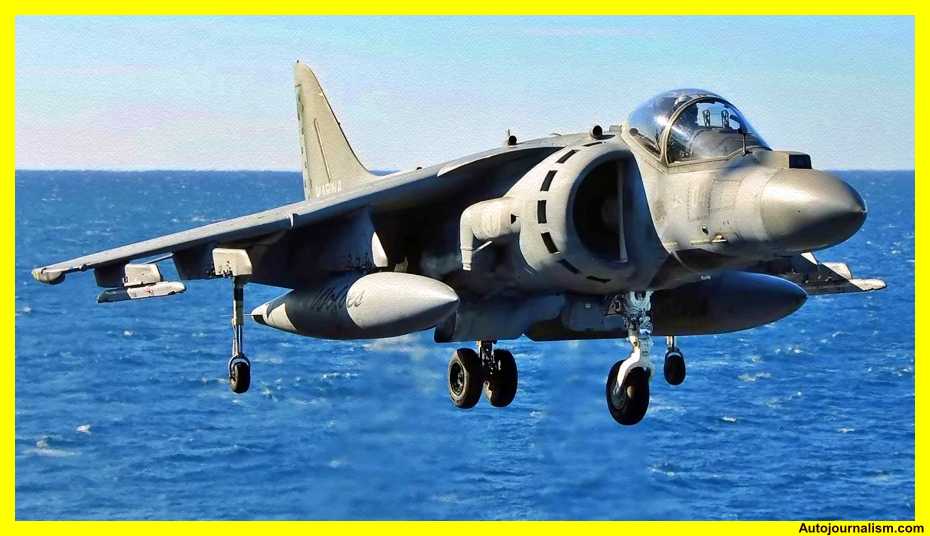
Here’s a comprehensive table detailing key specifications and features of the AV-8B Harrier II:
| Specification | Details |
|---|---|
| Role | V/STOL (Vertical/Short Takeoff and Landing) Attack Aircraft |
| Manufacturer | McDonnell Douglas (later Boeing) |
| Crew | 1 (Pilot) |
| Powerplant | 1 × Rolls-Royce Pegasus turbofan engine |
| Max Speed | 585 knots (673 mph, 1,083 km/h) at altitude |
| Range | 1,200 nautical miles (1,382 miles, 2,222 km) |
| Service Ceiling | 51,000 feet (15,545 meters) |
| Weight | Empty Weight: 13,968 lbs (6,332 kg) |
| Maximum Takeoff Weight: 31,000 lbs (14,061 kg) | |
| Armament | – 25 mm GAU-12/U Equalizer Rotary Cannon |
| – AIM-120 Advanced Medium-Range Air-to-Air Missile (AMRAAM) | |
| – AGM-65 Maverick Air-to-Ground Missile | |
| Avionics and Features | – Night Vision Imaging System (NVIS) compatible cockpit |
| – Forward-Looking Infrared (FLIR) sensor | |
| – Hands-On Throttle and Stick (HOTAS) controls | |
| Operational Modes | – Vertical Takeoff and Landing (VTOL) |
| – Short Takeoff and Vertical Landing (STOVL) | |
| – Conventional Takeoff and Landing (CTOL) | |
| Notable Variants | – AV-8B Harrier II Plus |
| – TAV-8B Harrier II (Two-seater trainer version) | |
| Operational Status | In service with the U.S. Marine Corps, Royal Air Force, Royal Navy, Spanish Navy, and Italian Navy |
The AV-8B Harrier II’s unique V/STOL capabilities and versatile armament make it a valuable asset in providing close air support to ground forces, with its ability to operate from various platforms and adapt to different mission requirements.
#3. C-17 Globemaster III Aircraft
The C-17 Globemaster III is a high-wing, four-engine tactical aircraft with exceptional cargo capabilities. Setting 22 world records, including short takeoff and landing achievements, the C-17 can transport a 160,000 lb payload over vast distances. Its versatility has made it a vital asset for military forces across the globe.
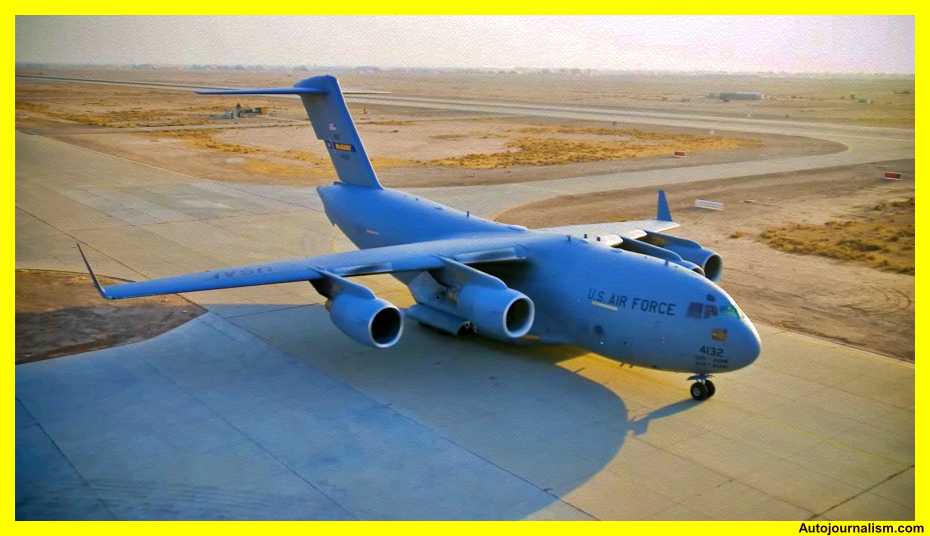
Here’s a comprehensive table detailing key specifications and features of the C-17 Globemaster III:
| Specification | Details |
|---|---|
| Role | Strategic and Tactical Airlift Transport Aircraft |
| Manufacturer | Boeing |
| Crew | 3 (Two Pilots and One Loadmaster) |
| Powerplant | 4 × Pratt & Whitney F117-PW-100 turbofan engines |
| Max Speed | Mach 0.74 (450 knots, 515+ mph, 830 km/h) at altitude |
| Range | 2,420 nautical miles (2,785 miles, 4,482 km) with max payload |
| Service Ceiling | 45,000 feet (13,716 meters) |
| Cargo Capacity | Max Payload: 170,900 lbs (77,519 kg) |
| Max Length: 88.6 feet (27 meters) | |
| Max Width: 18.3 feet (5.58 meters) | |
| Max Height: 12.5 feet (3.81 meters) | |
| Aerial Delivery System | Capability for airdrop of cargo and personnel |
| Via Low-Velocity Air Drop (LVAD) or High-Velocity Container Delivery System (HVCD) | |
| Operational Features | – Short Takeoff and Landing (STOL) Capability |
| – Fully Pressurized Cabin with In-Flight Refueling Capability | |
| – Advanced Avionics and Glass Cockpit Technology | |
| Strategic Capabilities | Ability to carry oversized cargo, including military vehicles |
| Capability to operate from austere airfields | |
| Records | Set 22 world records, including payload to altitude and time to climb |
| Notable Achievements | Winner of the National Aeronautic Association’s Annual Collier Trophy in 1994 |
| Deployed in June 1993 | |
| Operational Status | In service with the U.S. Air Force and other international operators |
The C-17 Globemaster III’s combination of versatility, strategic capabilities, and impressive records make it a crucial component of global airlift and military logistics operations.
#4. B-17 Flying Fortress Aircraft
The B-17 Flying Fortress, a symbol of U.S. air power during World War II, played a crucial role in the European theater. Boasting impressive resilience, it conducted strategic bombing missions, dropping over 640,000 bombs on designated targets. Although only four airworthy B-17s remain, its legacy endures.

Here’s a comprehensive table detailing key specifications and features of the B-17 Flying Fortress:
| Specification | Details |
|---|---|
| Role | Heavy Bomber |
| Manufacturer | Boeing |
| Crew | 10 (Pilot, Co-Pilot, Navigator, Bombardier, Flight Engineer, Radio Operator, and 4 Gunners) |
| Powerplant | 4 × Wright R-1820-97 “Cyclone” turbocharged radial engines |
| Max Speed | 287 mph (462 km/h) at 25,000 ft (7,620 meters) |
| Range | 2,000 miles (3,219 km) with 6,000 lb bomb load |
| Service Ceiling | 35,600 ft (10,851 meters) |
| Weight | Empty Weight: 36,135 lbs (16,391 kg) |
| Maximum Takeoff Weight: 65,500 lbs (29,710 kg) | |
| Armament | – 13 × .50 caliber (12.7 mm) M2 Browning machine guns |
| – Maximum Bomb Load: 8,000 lbs (3,629 kg) | |
| Defensive Features | – Self-sealing fuel tanks |
| – Armor protection for crew | |
| – Multiple gun positions for defense | |
| Operational Features | – High-altitude strategic bombing |
| – Long-range missions | |
| – Daylight precision bombing | |
| Production Numbers | Boeing: 12,731 units |
| Douglas: 655 units | |
| Lockheed Vega: 348 units | |
| Notable Achievements | – Symbol of U.S. Air Power during WWII |
| – Conducted extensive strategic bombing campaigns | |
| Post-War Use | – Transport Aircraft |
| – Air-Sea Rescue | |
| – Weather Reconnaissance | |
| Current Status | – 4 airworthy B-17s remain as of November 2022 |
| – None flown in combat |
The B-17 Flying Fortress, a symbol of American air power during World War II, played a crucial role in strategic bombing campaigns and remains an iconic piece of aviation history.
#5. B-52 Stratofortress Aircraft
The B-52, in its fifth decade of operational service, stands as the country’s first long-range swept-wing bomber. Originally designed for the high-altitude nuclear bombing, the B-52 evolved to meet diverse defense needs. With eight powerful Pratt & Whitney turbofan engines, it can carry a staggering 70,000 lb of ordinance over 8,800 miles without refueling.
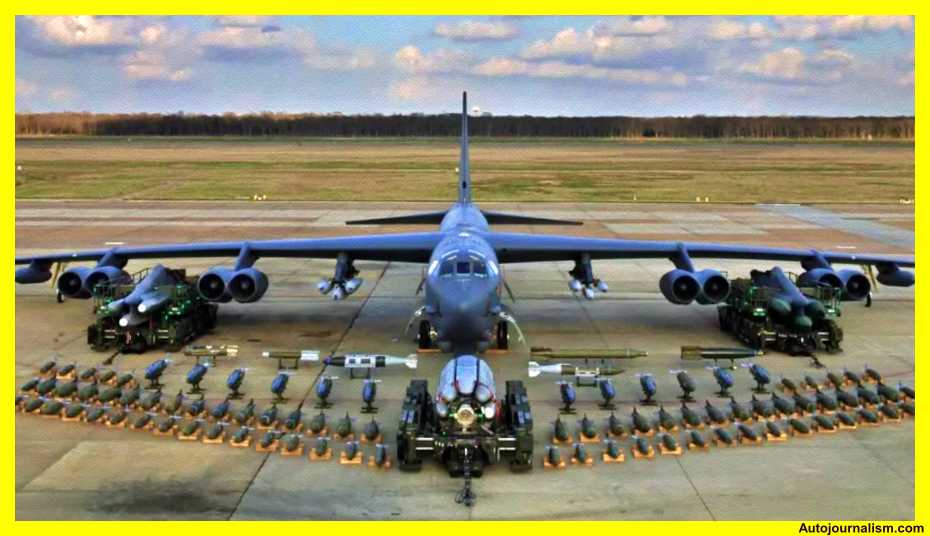
Here’s a comprehensive table detailing key specifications and features of the B-52 Stratofortress:
| Specification | Details |
|---|---|
| Role | Strategic Bomber |
| Manufacturer | Boeing |
| Crew | 5 (Pilot, Co-Pilot, Radar Navigator, Navigator, Electronic Warfare Officer) |
| Powerplant | 8 × Pratt & Whitney TF33-P-3/103 turbofan engines |
| Max Speed | Mach 0.86 (650 mph, 1,046 km/h) at 35,000 ft (10,668 meters) |
| Range | 8,800 miles (14,080 km) with external fuel tanks |
| Service Ceiling | 50,000 ft (15,240 meters) |
| Weight | Empty Weight: 185,000 lbs (83,250 kg) |
| Maximum Takeoff Weight: 488,000 lbs (220,000 kg) | |
| Payload | 70,000 lbs (31,500 kg) of mixed ordnance |
| Defensive Features | – Radar jamming systems |
| – Chaff and flare dispensers | |
| – Tail gun for close-in defense | |
| Operational Features | – High-altitude strategic bombing |
| – Low-level flight capabilities | |
| – Conventional and nuclear payload options | |
| Production Numbers | 744 B-52s built in various versions between 1952 and 1962 |
| Upgrades | – Avionics modernization programs (ongoing) |
| – Engine upgrades (TF33-P-3 to TF33-P-3/103) | |
| Current Status | Active service with the U.S. Air Force |
| Expected to remain in service into the 2050s | |
| Notable Records | Set various records including range, payload, and altitude |
| Historical Significance | Integral role during the Cold War and subsequent conflicts |
| Longest-serving bomber in the U.S. Air Force fleet |
The B-52 Stratofortress, with its enduring legacy and continuous upgrades, stands as a testament to its design robustness and adaptability in the ever-evolving landscape of military aviation.
#6. CH-47 Chinook Aircraft
The CH-47 Chinook helicopters, introduced in 1962, have been crucial in various military operations. Evolving through different versions, including the CH-47F, they remain a standard for the U.S. Army. Widely used in the Gulf War and ongoing counter-terrorism efforts, these helicopters exemplify Boeing’s commitment to versatility and reliability.
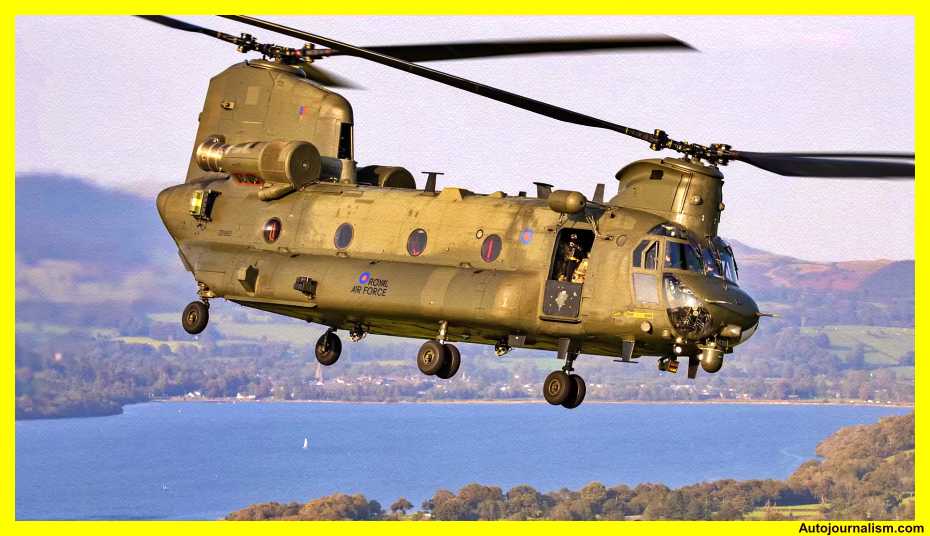
Here’s a comprehensive table detailing key specifications and features of the CH-47 Chinook:
| Specification | Details |
|---|---|
| Role | Tandem Rotor Heavy-Lift Helicopter |
| Manufacturer | Boeing |
| Crew | 2 (Pilot and Co-Pilot) |
| Powerplant | 2 × Honeywell T55-GA-714A turboshaft engines |
| Max Speed | 170 knots (196 mph, 315 km/h) |
| Range | 200 nautical miles (230 miles, 370 km) |
| Service Ceiling | 18,500 ft (5,640 meters) |
| Weight | Empty Weight: 24,578 lbs (11,129 kg) |
| Maximum Takeoff Weight: 50,000 lbs (22,680 kg) | |
| Payload Capacity | Internal: 24,000 lbs (10,886 kg) |
| External: 26,000 lbs (11,793 kg) | |
| Cargo Bay Dimensions | Length: 24.1 ft (7.3 meters) |
| Width: 6.7 ft (2.04 meters) | |
| Height: 5.8 ft (1.8 meters) | |
| Rotor Diameter | 60 ft (18.29 meters) |
| Operational Features | – Tandem rotor system for stability |
| – Rear ramp for quick loading/unloading | |
| – Ability to carry a wide range of cargo and vehicles | |
| Mission Capabilities | – Troop transport |
| – Medevac (Medical Evacuation) | |
| – Cargo and equipment transport | |
| Variants | – CH-47A, CH-47B, CH-47C, CH-47D, CH-47F, MH-47 |
| – Special Operations variants (MH-47G) | |
| Operational Status | In service with various military forces globally |
| Total Units Built | Over 1,200 units |
The CH-47 Chinook’s unique tandem rotor design and versatile payload capacity make it a workhorse in military aviation, capable of performing a wide range of missions and providing critical support in various operational scenarios.
#7. B-29 Superfortress Aircraft
The B-29 Superfortress, a World War II innovation, featured remote-controlled guns, pressurized crew areas, and advanced aerodynamics. With its heavy payload capacity, it became the heaviest production plane of its time. The B-29’s legacy includes upgrades to the B-50 and its use as a reconnaissance aircraft.

Here’s a comprehensive table detailing key specifications and features of the B-29 Superfortress:
| Specification | Details |
|---|---|
| Role | Very Long-Range Strategic Bomber |
| Manufacturer | Boeing |
| Crew | 11 (Pilot, Co-Pilot, Bombardier, Navigator, Flight Engineer, Radio Operator, Radar Operator, Central Fire Control Gunner, Left and Right Gunners, Tail Gunner) |
| Powerplant | 4 × Wright R-3350-23 Duplex-Cyclone turbocharged radial engines |
| Max Speed | 357 mph (576 km/h) at 30,000 ft (9,144 meters) |
| Range | 3,250 miles (5,230 km) with max bomb load |
| Service Ceiling | 31,850 ft (9,708 meters) |
| Weight | Empty Weight: 74,500 lbs (33,792 kg) |
| Maximum Takeoff Weight: 133,500 lbs (60,555 kg) | |
| Payload Capacity | Maximum Bomb Load: 20,000 lbs (9,072 kg) |
| Defensive Armament | – 12 × .50 caliber (12.7 mm) M2 Browning machine guns |
| – Tail gun: 1 × 20 mm M2 cannon | |
| Avionics and Features | – Remote-controlled gun systems |
| – Pressurized crew compartments | |
| – Long-range bombing capabilities | |
| Wingspan | 141 ft 3 in (43.1 meters) |
| Length | 99 ft (30.18 meters) |
| Height | 27 ft 9 in (8.46 meters) |
| First Flight | September 21, 1942 |
| Total Units Built | 3,970 units (including variants) |
| Notable Variants | – B-29A, B-29B, B-29D, B-29E, B-29J |
| – RB-29 (Photo Reconnaissance) | |
| Post-War Use | – Enola Gay and Bockscar used in atomic bombings of Hiroshima and Nagasaki |
| – Continued service as a reconnaissance aircraft | |
| – KB-29 aerial refueling tanker conversions | |
| Status | No airworthy B-29s remain; museum displays only |
The B-29 Superfortress, known for its role in the Pacific theater during World War II and as the aircraft that dropped atomic bombs on Japan, remains a historic and significant symbol of military aviation.
#8. B-47 Stratojet Aircraft
The B-47 Stratojet, introduced in 1947, set new design standards with its swept-wing configuration. Equipped with six engines, it utilized 18 small rocket units for takeoff. Its pioneering design influenced subsequent large jet aircraft, showcasing Boeing’s commitment to pushing boundaries.
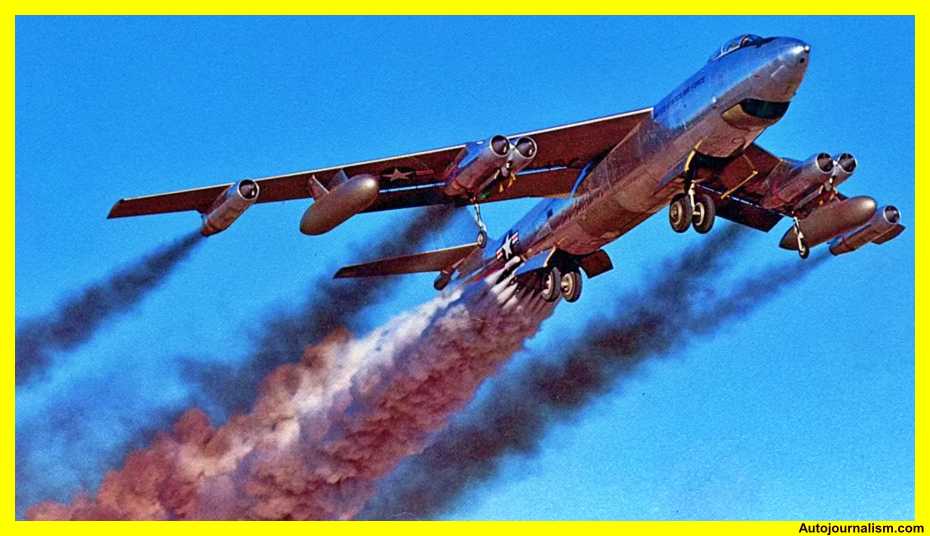
Here’s a comprehensive table detailing key specifications and features of the B-47 Stratojet:
| Specification | Details |
|---|---|
| Role | Strategic Jet Bomber |
| Manufacturer | Boeing |
| Crew | 3 (Pilot, Co-Pilot, Navigator/Bombardier) |
| Powerplant | 6 × General Electric J47-GE-25 turbojet engines |
| Max Speed | Mach 0.86 (654 mph, 1,052 km/h) at 20,000 ft (6,096 meters) |
| Range | 2,430 miles (3,910 km) with maximum payload |
| Service Ceiling | 40,000 ft (12,192 meters) |
| Weight | Empty Weight: 78,610 lbs (35,672 kg) |
| Maximum Takeoff Weight: 200,000 lbs (90,719 kg) | |
| Payload Capacity | Up to 25,000 lbs (11,340 kg) of bombs internally |
| Wingspan | 116 ft (35.36 meters) |
| Length | 107 ft 1 in (32.64 meters) |
| Height | 28 ft 11 in (8.81 meters) |
| Defensive Armament | – 2 × 20 mm M24A1 autocannons in tail turret |
| Avionics and Features | – Swept-wing design for high-speed flight |
| – Terrain-following radar for low-level flight | |
| – Jet-assisted takeoff (JATO) capability | |
| Operational Features | – Designed for high-altitude, high-speed bombing |
| – Capability for low-level flight and maneuverability | |
| Production Numbers | 2,032 B-47s built between 1947 and 1957 |
| Notable Achievements | – Influenced subsequent bomber designs |
| – Key component of the Strategic Air Command (SAC) | |
| Legacy | – First swept-wing jet bomber in U.S. service |
| – Transitioned the U.S. from propeller-driven to jet-powered strategic bombers | |
| Retirement | Phased out of service in the 1960s |
The B-47 Stratojet, with its advanced design and significant role in shaping strategic bombing capabilities, played a pivotal role in the early years of the Cold War.
#9. F/A-18 Hornet Aircraft
The F/A-18 Hornet, with its carbon fiber wings and digital fly-by-wire flight controls, has been a versatile workhorse in tactical aviation. With variants including a two-seater, an improved fighter, a reconnaissance aircraft, and a night attack fighter, the Hornet has served in various capacities since its introduction in 1978.
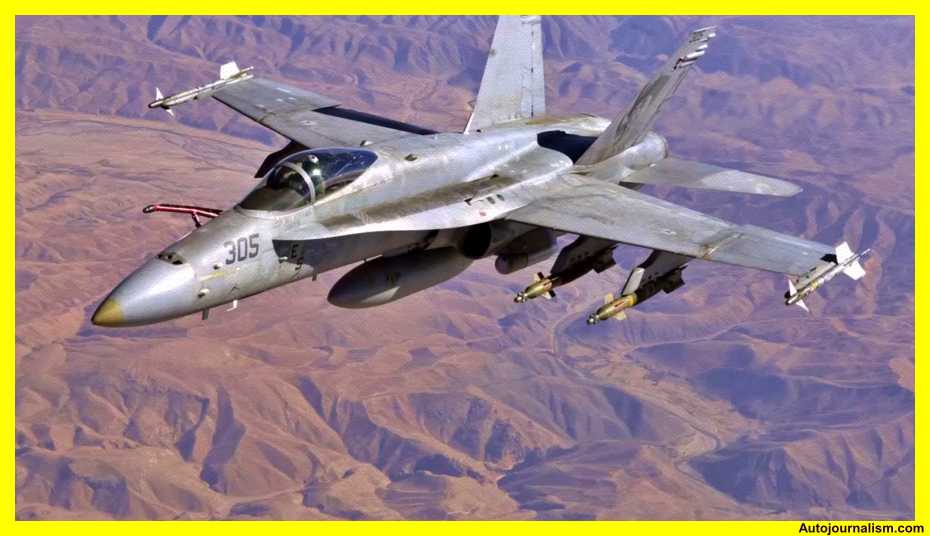
Here’s a comprehensive table detailing key specifications and features of the F/A-18 Hornet:
| Specification | Details |
|---|---|
| Role | Multirole Fighter/Attack Aircraft |
| Manufacturer | McDonnell Douglas (now Boeing) |
| Crew | 1 (Pilot) |
| Powerplant | 2 × General Electric F404-GE-402 turbofan engines |
| Max Speed | Mach 1.8 (1,190 mph, 1,915 km/h) at altitude |
| Range | 1,275 nautical miles (2,346 km) |
| Service Ceiling | 50,000+ ft (15,240+ meters) |
| Weight | Empty Weight: 24,500 lbs (11,113 kg) |
| Maximum Takeoff Weight: 51,900 lbs (23,509 kg) | |
| Armament | – 1 × 20 mm M61 Vulcan rotary cannon |
| – Air-to-air and air-to-ground missiles | |
| – Precision-guided munitions | |
| Avionics and Features | – AN/APG-65 Radar System |
| – Upgraded versions feature AN/APG-73 radar | |
| – Digital Fly-by-Wire Flight Control System | |
| Operational Modes | – Air-to-air combat |
| – Air-to-ground strike missions | |
| – Electronic warfare and reconnaissance | |
| Variants | – F/A-18A, F/A-18B (Two-seater training version) |
| – F/A-18C, F/A-18D (Upgraded and improved versions) | |
| – EA-18G Growler (Electronic Warfare variant) | |
| Operational Status | In service with various air forces globally |
| Total Units Built | Over 1,500 units |
The F/A-18 Hornet, known for its versatility and reliability, serves as a multirole workhorse in the air forces of various nations. Its ability to perform a wide range of missions, from air-to-air combat to ground attack, makes it a vital asset in modern aerial warfare.
#10. McDonnell Douglas F-15 Eagle Aircraft
The F-15 Eagle, distinguished by its powerful twin engines, became the U.S. Air Force’s premier fighter by 2002. With an impeccable record of 100 wins and no losses, it played a significant role in Operation Desert Storm in 1991. The F-15E Strike Eagle, introduced in 1988, continues to showcase high-tech advancements.
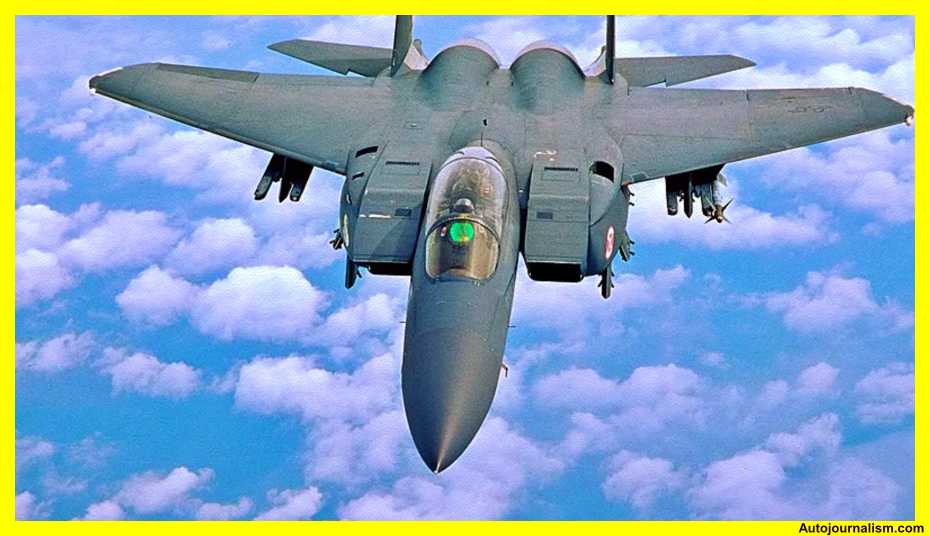
Here’s a comprehensive table detailing key specifications and features of the McDonnell Douglas F-15 Eagle:
| Specification | Details |
|---|---|
| Role | Air Superiority Fighter |
| Manufacturer | McDonnell Douglas (now Boeing) |
| Crew | 1 (Pilot) |
| Powerplant | 2 × Pratt & Whitney F100-PW-100 afterburning turbofan engines |
| Max Speed | Mach 2.5+ (1,650 mph, 2,654 km/h) at altitude |
| Range | 3,450 nautical miles (4,000 miles, 6,437 km) with conformal fuel tanks |
| Service Ceiling | 65,000+ ft (19,812+ meters) |
| Weight | Empty Weight: 28,000 lbs (12,700 kg) |
| Maximum Takeoff Weight: 68,000 lbs (30,845 kg) | |
| Armament | – 1 × 20 mm M61 Vulcan rotary cannon |
| – Air-to-air missiles (AIM-7 Sparrow, AIM-120 AMRAAM) | |
| – Air-to-ground munitions | |
| Avionics and Features | – AN/APG-63 and AN/APG-70 Radar Systems |
| – Heads-Up Display (HUD) | |
| – Radar Warning Receiver (RWR) | |
| Operational Modes | – Air Superiority |
| – Interception | |
| – Ground Attack | |
| Variants | – F-15A, F-15B (Single-seat and Two-seat variants) |
| – F-15C, F-15D (Improved versions) | |
| – F-15E Strike Eagle (Multirole variant) | |
| – F-15EX (Latest variant with modern upgrades) | |
| Operational Status | In service with various air forces globally |
| Total Units Built | Over 1,600 units |
The F-15 Eagle, renowned for its air superiority capabilities and continuous upgrades, has been a cornerstone in the fleets of several air forces worldwide, showcasing exceptional performance and combat effectiveness.
Bonus: Joint Strike Fighter X32 Aircraft
Although not selected for full-scale development, the Joint Strike Fighter X32, part of the Joint Strike Fighter program, contributed significantly to advances in stealth technology and design. Boeing’s innovations from this program have influenced other projects, demonstrating the company’s commitment to progress.

Here’s a comprehensive table detailing key specifications and features of the Joint Strike Fighter X-32:
| Specification | Details |
|---|---|
| Role | Multirole Fighter |
| Manufacturer | Boeing |
| Crew | 1 (Pilot) |
| Powerplant | 1 × Pratt & Whitney F119 afterburning turbofan engine |
| Max Speed | Mach 1.6 (1,200 mph, 1,930 km/h) at altitude |
| Range | Approx. 850 nautical miles (982 miles, 1,578 km) |
| Service Ceiling | 50,000+ ft (15,240+ meters) |
| Weight | Empty Weight: Approx. 22,000 lbs (9,979 kg) |
| Maximum Takeoff Weight: Approx. 50,000 lbs (22,680 kg) | |
| Armament | – Internal weapons bays |
| – Air-to-air and air-to-ground munitions | |
| Avionics and Features | – Advanced Radar and Sensor Systems |
| – Glass Cockpit Technology | |
| – Low Observability Design (Stealth) | |
| Operational Modes | – Air-to-air combat |
| – Air-to-ground strike missions | |
| – Electronic warfare capabilities | |
| Variants | – X-32A, X-32B (Concept demonstration aircraft) |
| Operational Status | Not selected for full-scale development (Lost to the Lockheed Martin X-35 in the Joint Strike Fighter competition) |
| Legacy | Although not selected, insights and technologies from the X-32 program influenced subsequent aircraft development |
The Joint Strike Fighter X-32, part of the competition to become the next-generation Joint Strike Fighter, was ultimately not chosen for production. The Lockheed Martin X-35, which later became the F-35 Lightning II, won the competition and is currently in active service with various air forces globally.
Conclusion:
- Boeing’s legacy in military aviation is marked by a series of groundbreaking aircraft that have shaped the course of history. From iconic bombers to agile helicopters, Boeing continues to innovate and contribute to the evolution of military aircraft. The top 10 Boeing military aircraft listed here showcase the company’s commitment to innovation, performance, and meeting the evolving needs of defense forces worldwide. As we reflect on these top 10 military aircraft and the bonus mention, it’s clear that Boeing’s commitment to excellence remains unwavering in the ever-changing landscape of aerospace technology.
Previous Post: Top 10 Largest Aircraft Manufacturers In The World 2024
Source: Internet + Previous Knowledge + YouTube – Here is the YT link
